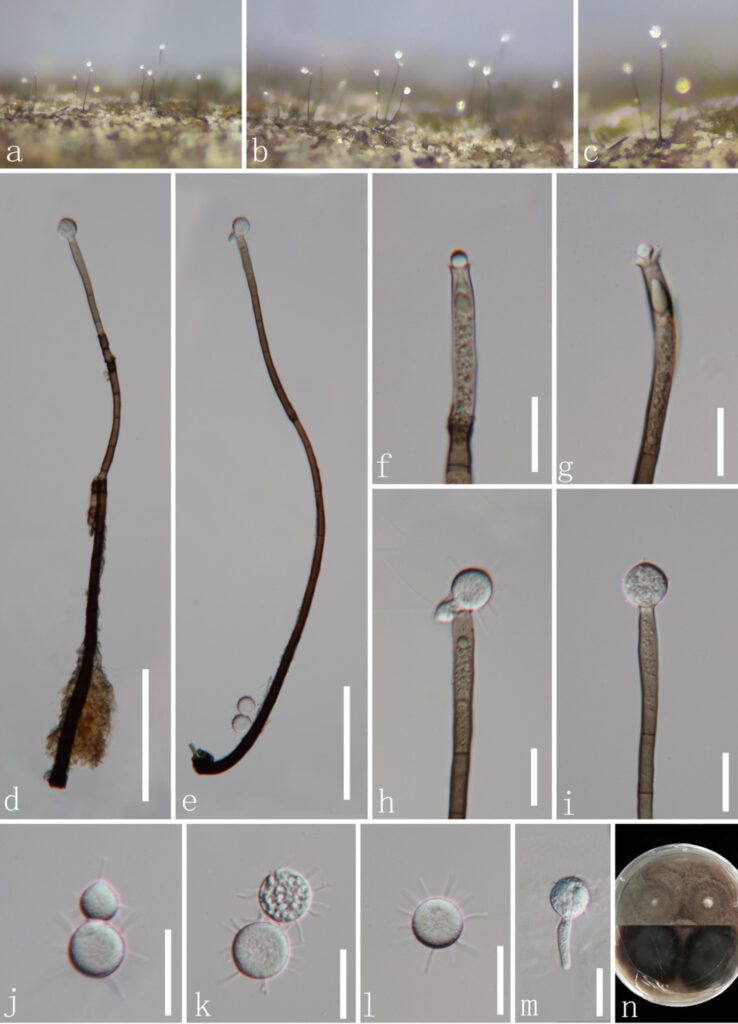Codinaea dwaya (Subram. & J. Bhat) Réblová & Hern.-Restr., Journal of Fungi 7(12, no. 1097): 31 (2021).
MycoBank number: MB 842192; Index Fungorum number: IF 842192; Facesoffungi number: FoF 11037;
Holotype – MUBL 2351
Saprobic on decaying wood submerged in freshwater habitats. Sexual morph: Undetermined. Asexual morph: hyphomycetous. Colonies on natural substrate superficial, effuse, scattered, brown, with glistening masses of conidia on the apex of conidiophores. Mycelium 1.3–2.4 μm wide, mostly immersed, composed of pale brown, septate hyphae. Conidiophores (360–)440–620 × 7.6–14 μm (x̅ = 527.7 × 9.9 μm, n = 20), macronematous, mononematous, erect, straight or slightly flexuous, occasionally branched, cylindrical, solitary, septate, smooth-walled, dark brown, becoming paler brown towards the apex. Conidiogenous cells (17–)35–62.5 × 5.6–8 μm (x̅ = 50.2 × 6.6 μm, n = 20), monophialidic, terminal, integrated, cylindrical, guttulate, with an inconspicuous apical collarette. Conidia in succession by percurrent proliferation from a single fertile locus, spherical,13.4–17 μm diam. (x̅ = 15.5μm), amerospores, aseptate, acrogenous, in groups, accumulating in a slimy mass at the tip of the phialide, rough-walled, hyaline, with 7–13 hair-like and 6.4–9.9 μm long appendages at both ends.
Culture characteristics – Conidia germinating on PDA within 16 h and germ tube produced from conidia. Colonies growing on PDA, reaching 25 mm diam. in 10 days at 25°C, circular. Mycelium slightly raised, taupe dark brown with a white protuberance in the center, entire to slightly filamentous, becoming taupe to dark brown towards the edge in reverse and not producing pigmentation in culture.
Material examined – CHINA, Hainan province, Diaoluo Mountain National Nature Reserve, on decaying wood submerged in a freshwater stream, 20 Augest 2021, Wei-Guo Lin, DL1-1 (GZAAS 22-0071), living cultures, GZCC 22-0080.
GenBank accession numbers – LSU ON502889, ITS ON502896.
Notes: Following BLASTn searches of NCBI GenBank, the closest matches of the LSU and ITS sequences of our new isolate is Codinaea dwaya (strain CBS 261.77; LSU, OL654135, 99.88% shared identity; ITS, OL654078, 97.79% shared identity). Our new collection fits well with the description of species of Co. dwaya in having mononematous conidiophores, integrated, terminal, cylindrical, phialidic conidiogenous cells and hyaline, spherical, aseptate conidia with setulae (Wu and McKenzie 2003; Goh et al. 2001; Subramanian and Bhat 1977; Réblová et al. 2021b). Phylogenetically, our isolate grouped together with Co. dwaya (CBS 261.77) with a high support value (Figure 1, 100% ML/ 1.00 MP). Thus, we identify this new specimen as Co. dwaya.

Figure 3. Codinaea dwaya (GZAAS 22-0071). (a–c) Colonies on woody substrate; (d,e) Conidiophores and conidia; (f–i) Conidiogenous cells; (j–l) Conidia; (m) Germinating conidium; (n) Culture on PDA. Scale bars: (d,e) 100 μm; (f–m) 20 μm.
